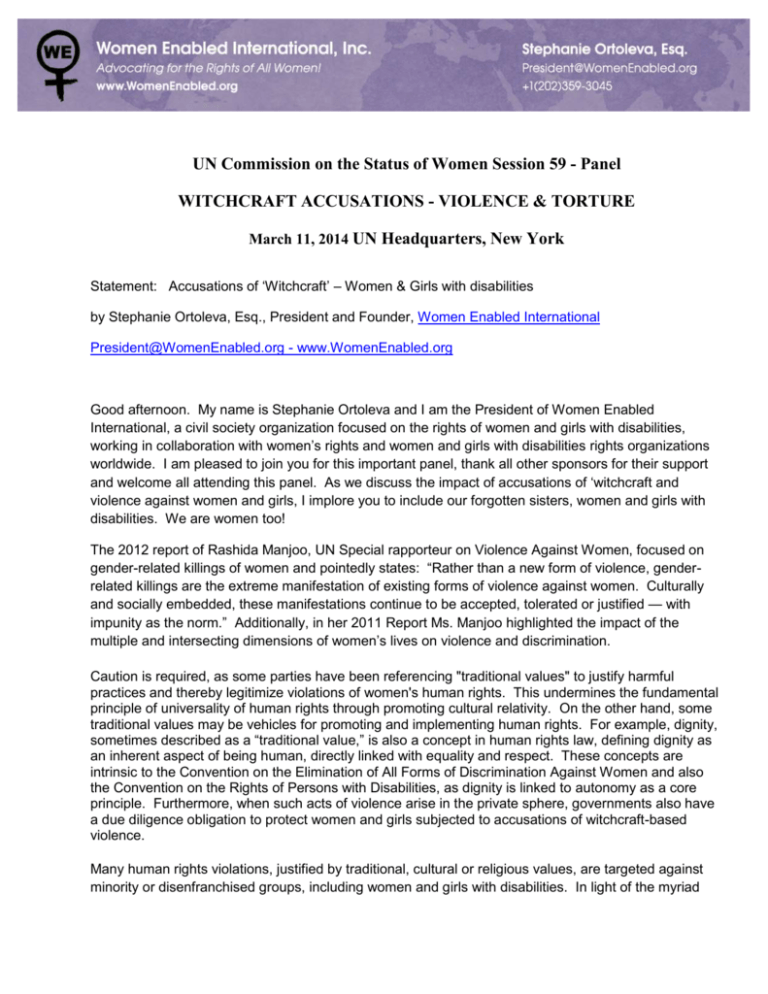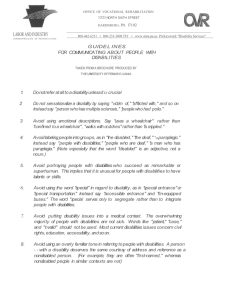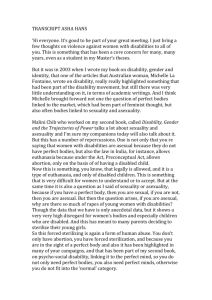Word Doc - Women Enabled International
advertisement

Women Enabled International, Inc. Advocating for the Rights of All Women! www.WomenEnabled.org Stephanie Ortoleva, Esq. President@WomenEnabled.org +1(202)359-3045 UN Commission on the Status of Women Session 59 - Panel WITCHCRAFT ACCUSATIONS - VIOLENCE & TORTURE March 11, 2014 UN Headquarters, New York Statement: Accusations of ‘Witchcraft’ – Women & Girls with disabilities by Stephanie Ortoleva, Esq., President and Founder, Women Enabled International President@WomenEnabled.org - www.WomenEnabled.org Good afternoon. My name is Stephanie Ortoleva and I am the President of Women Enabled International, a civil society organization focused on the rights of women and girls with disabilities, working in collaboration with women’s rights and women and girls with disabilities rights organizations worldwide. I am pleased to join you for this important panel, thank all other sponsors for their support and welcome all attending this panel. As we discuss the impact of accusations of ‘witchcraft and violence against women and girls, I implore you to include our forgotten sisters, women and girls with disabilities. We are women too! The 2012 report of Rashida Manjoo, UN Special rapporteur on Violence Against Women, focused on gender-related killings of women and pointedly states: “Rather than a new form of violence, genderrelated killings are the extreme manifestation of existing forms of violence against women. Culturally and socially embedded, these manifestations continue to be accepted, tolerated or justified — with impunity as the norm.” Additionally, in her 2011 Report Ms. Manjoo highlighted the impact of the multiple and intersecting dimensions of women’s lives on violence and discrimination. Caution is required, as some parties have been referencing "traditional values" to justify harmful practices and thereby legitimize violations of women's human rights. This undermines the fundamental principle of universality of human rights through promoting cultural relativity. On the other hand, some traditional values may be vehicles for promoting and implementing human rights. For example, dignity, sometimes described as a “traditional value,” is also a concept in human rights law, defining dignity as an inherent aspect of being human, directly linked with equality and respect. These concepts are intrinsic to the Convention on the Elimination of All Forms of Discrimination Against Women and also the Convention on the Rights of Persons with Disabilities, as dignity is linked to autonomy as a core principle. Furthermore, when such acts of violence arise in the private sphere, governments also have a due diligence obligation to protect women and girls subjected to accusations of witchcraft-based violence. Many human rights violations, justified by traditional, cultural or religious values, are targeted against minority or disenfranchised groups, including women and girls with disabilities. In light of the myriad impacts of some traditional myths and cultural views of disability, combined with attitudes toward women in general, women and girls with disabilities are in a double bind. These linkages must be addressed from a gender-sensitive, disability-inclusive approach. The notion that disability is a “curse” and that people with disabilities are “possessed” or “evil” and the societal views of women as “witches” or “demonic,” persists today, with origins dating from 1485 and earlier and these violations are found in all countries. Murder of women and girls with disabilities as witches is highlighted as a human rights violation by Philip Alston, Former UN Special rapporteur on extrajudicial, summary or arbitrary executions in his 2009 Report. The medieval notion that one can identify a “witch” by the fact that her offspring are children with disabilities still persists. Further, having an offspring with a disability is seen as a curse on the woman herself for some wrongdoing or breach of a societal taboo. Women and girls who challenge accepted socio-cultural norms, traditions, perceptions and stereotypes about femininity and the role, behavior and status of women and girls in society are often labeled with psychosocial disabilities. As a mechanism of control, they frequently are subjected to forced psychiatric interventions and treatment that are harmful and deprive them of legal capacity and autonomy, resulting in the erasure of personhood. Professor Nora Groce focuses on the persistent misguided myth that sex with a woman or girl with a disability, because of the assumption that she is a virgin, can cure HIV/AIDS, resulting in rapes of women and girls with disabilities and increased risk of HIV-infection and unwanted pregnancy. Special Rapporteur Alston notes that women and children with albinism are hunted and killed based on superstitious beliefs that their skin or body parts transmit magical powers which bring good health or prosperity. In other cases, they are killed based on the belief that they are evil or cursed. Recently, UN High Commissioner for Human Rights Zeid Ra’ad Al Hussein expressed outrage that over the past six months at least 15 people with albinismwere kidnapped, woundedor killed. Of the 15 cases highlighted, Other violations also cross borders and cultures based on traditional values regarding the value of the lives of women and girls with disabilities. Neglect, through starvation or ill-treatment often results in severe injury, health impacts and sometimes even death. Parents may refuse to register the births of girls with disabilities or, even worse, kill them because of the family’s view that it lacks the capacity or willingness to nurture, support and care for a girl child who they and the community consider useless and a burden. Forced sterilization and imposed contraception and abortion are based on cultural attitudes about the value of the lives of women and girls with disabilities, as well as their right to self-determination, are often sought by parents or guardians and with the support of the legal system. Australia was called to task for sanctioning such practices by both the CEDAW Committee and the Human rights Council, Columbia also has been cited by the CEDAW Committee for violations based on forced sterilization and France was sued by five women before the European Court of Human Rights. Accusations of witchcraft generally ae hurled at women by men who label women as witches in order to assert their patriarchal power over women and children. Interestingly, under the medical model view of disability, disability is something to be “cured” and similarly, action taken against those accused of witchcraft often is also taken to allegedly “cure” them of the evil spirits which allegedly possess them. Researcher Eleanor Ann Nwadinobi notes that the harmful practices and alleged treatments imposed on those accused of witchcraft or saucery are an extreme example of violations of the Right to Health as enumerated in the Universal Declaration of Human Rights and the International Covenant on Economic, Social and Cultural Rights, among other international instruments. Additionally, in some areas, illness and disability are seen as a curse of a witch, thus justifying killing of the alleged witch whose curse caused the illness or disability. Of course, often the physical and psychological harm of accusations of witchcraft can exacerbate existing disabilities and result in new disabilities among women and girls. Women and girls with disabilities, like all women and girls, are subjected to harmful practices such as female genital mutilation, forced marriage, and rape (including rape by a spouse. Forced marriage in the context of disability is based on misguided ideas that the daughter with a disability will need someone to care for and financially support her or that if she does not marry, her siblings will not be viewed as eligible for marriage by the community or the young woman with a disability is forced to marry a man who has “disgraced family honor.” Women and girls with disabilities are subjected to gender-specific and disability-specific harmful traditional practices, and therefore are more discriminated against, violated, marginalized and exploited. The role of human rights education, focusing on core human rights principles and traditional values that coincide with those principles is an important tool for change. States are responsible for taking systematic action to modify or eliminate stereotypes and negative, harmful and discriminatory practices justified by traditional values. Both approaches are required under the CEDAW and the CRPD. The basic absence of data on accusations of witchcraft and resultant harm to women and girls with disabilities must be remedied with accurate and disability and gender-desegregated data. Additionally, to ensure that the rights of women and girls with disabilities are included as we embark on this discussion, the international women’s rights movement must include our sisters with disabilities in analysis and advocacy. If you would like to explore these ideas further, please contact me at President@WomenEnabled.org. Thank you. Resources: Stephanie Ortoleva & Hope Lewis: “Forgotten Sisters - A Report on Violence against Women with Disabilities: & Overview of Its Nature, Scope, Causes & Consequences,” available at: http://papers.ssrn.com/sol3/papers.cfm?abstract_id=2133332. Rashida Manjoo, Special Rapporteur on Violence Against Women, Report of the Special Rapporteur on Violence Against Women, Its Causes and Consequences, Report on Violence Against Women with Disabilities, U.N. Doc. A/67/227 (August 3, 2012), available at: http://www.un.org/ga/search/view_doc.asp?symbol=A%2F67%2F227+&Submit=Search&Lang=E Rashida Manjoo, UN Special Rapporteur on Violence Against Women, Report to the Human Rights Council: Gender-Related Killings of Women, 23 May 2012, A/HRC/20/16, available at: http://www.ohchr.org/Documents/Issues/Women/A.HRC.20.16_En.pdf Rashida Manjoo, Special Rapporteur on Violence against Women, Report of the Special Rapporteur on Violence against Women, its Causes and Consequences, (considering multiple and intersecting forms of discrimination) U.N. Doc. A/HRC/17/26 (May 2, 2011), available at http://www2.ohchr.org/english/bodies/hrcouncil/docs/17session/A-HRC-17-26.pdf Philip Alston, UN Special Rapporteur on extrajudicial, summary or arbitrary executions, REPORT TO THE Human Rights council, 27 May 2009, A/HRC/11/2 27, available at: http://www2.ohchr.org/english/bodies/hrcouncil/docs/.../A.HRC.11.2.pdf. Human Rights Council resolution A-HRC-23-L.25 on attacks and discrimination against persons with albinism, available at: https://docs.google.com/document/d/1BsyQ6Rh1ujxnYsNg92DKZdt4P0lL1yZxjL_34du544/edit?pli=1 . U.N. High Comm’r for Human Rights, Women’s Rights and Gender Section, Responses to the Note Verbale on Human Rights Council Resolution 17/11: "Violence against women and girls and disability,” http://www2.ohchr.org/english/issues/women/docs/A.HRC.20.5.pdf. UN High Commissioner for Human Rights Zeid Ra’ad Al Hussein expressed revulsion at a recent surge in violent attacks against people with albinism in several East African countries, Press Release, March 10, 2015, http://www.ohchr.org/EN/NewsEvents/Pages/DisplayNews.aspx?NewsID=15673&LangID=E. Convention on the Elimination of All Forms of Discrimination against Women, G.A. Res. 34/180, U.N. Doc. A/RES/34/180 (Dec. 18, 1979), available at http://www.unhcr.org/refworld/docid/3ae6b3970.html. Convention on the Rights of Persons with Disabilities, G.A. Res. 61/106, U.N. Doc. A/RES/61/106 (Dec. 13, 2006), available at http://www.unhcr.org/refworld/docid/45f973632.html. David W. Anderson, Ed.D., Human Rights and Persons with Disabilities in Developing Nations of Africa, 2004, http://www4.samford.edu/lillyhumanrights/papers/Anderson_Human.pdf Forced Marriage and Learning Disabilities: Multi-Agency Practice Guidelines, (December 2010) p. 6, available at: http://www.fco.gov.uk/resources/en/pdf/travel-living-abroad/when-things-go-wrong/fmdisability-guidelines. Eleanor Ann Nwadinobi, “Harmful Cultural Practices in the Context of the Right to Health: The Case of Child Witchcraft Accusations in Akwa Ibom State of Nigeria”, AfricaAfricAgenda Limited (2011). Gary Foxcroft, Hunting Witches, World Policy Journal (Spring 2014), available at: http://www.wunrn.com/pdf/witchcraft2.pdf. © Copyright March 2015







